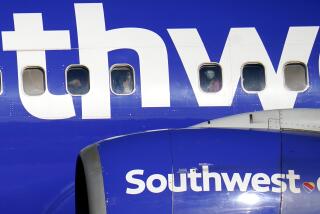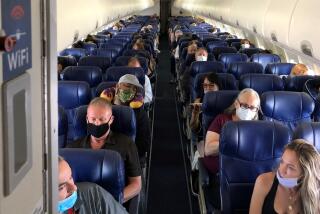FAA has cleared portable oxygen concentrators for takeoff
- Share via
FOR the more than 1 million Americans who have lung disease and depend on supplementary oxygen, there’s now more freedom to move about the country.
In a ruling that went into effect last week, the Federal Aviation Administration will now allow passengers to take either of two brands of portable oxygen concentrators for use on airplanes. Previously, fliers were prohibited from taking any form of oxygen on board.
For now, only the AirSep LifeStyle and Inogen One concentrators can be used on planes, but other manufacturers are expected to seek FAA approval for their units too.
The ruling leaves it up to the carriers to decide whether they will accept oxygen concentrators on board. Some are just now gearing up to implement the ruling; many are considering it.
Continental and American said they would allow passengers to take oxygen concentrators onboard. Southwest, America West and United said they were discussing the issue.
At the Travel section’s press time Tuesday, Continental was planning to accept passengers traveling with the approved oxygen concentrators starting Friday, said Martin DeLeon, an airline spokesman. DeLeon and other airline officials said it would take time to train workers in the care of the concentrators and work out other details.
American did not know when it would launch its new policy, spokesman Tim Smith said.
The ruling eliminates the need to arrange oxygen delivery on board an aircraft, during layovers and at destinations, making travel easier for oxygen-dependent fliers who choose cooperating airlines.
Because they are not required to do so, not all airlines provide passengers with portable oxygen. Those that do typically charge about $100 for each flight segment for the service. Even when the airline provides in-flight oxygen equipment, passengers still have to arrange for oxygen delivery from medical suppliers during layovers and at their destination.
Under the new regulation, passengers can use oxygen concentrators during all flight phases, including taxiing, landing and taking off, and while moving about the cabin if the seat belt sign is off. They also can use them at their destinations, without the need to arrange for other equipment.
Traditional portable tanks contain compressed, 100% oxygen, West said, and other portable units contain liquid oxygen. The airlines control their use on board.
Unlike liquid-oxygen devices or oxygen tanks, concentrators are not classified as hazardous materials, said Daryl Risinger, a spokesman for Inogen, based in Goleta, Calif.
“Portable oxygen concentrators work by removing nitrogen from the air, leaving you with mostly oxygen,” said Cheryl West, director of governmental affairs for the American Assn. for Respiratory Care in Dallas, an organization of respiratory therapists and other healthcare professionals.
The units, which weigh about 10 pounds, work on a battery or electrical current.
“Eventually, all the airlines will allow the concentrators,” said Joseph Priest, president of AirSep, which makes LifeStyle. It’s less hassle for them, he added, because it gets them “out of the oxygen business.”
Until then, oxygen-dependent passengers who use one of the two approved units should check with their airline to see whether it allows them. Another source of information is medical suppliers, who should be up to date on carriers that allow concentrators.
*
Healthy Traveler appears every other week. Kathleen Doheny can be reached at [email protected].
More to Read
Inside the business of entertainment
The Wide Shot brings you news, analysis and insights on everything from streaming wars to production — and what it all means for the future.
You may occasionally receive promotional content from the Los Angeles Times.










